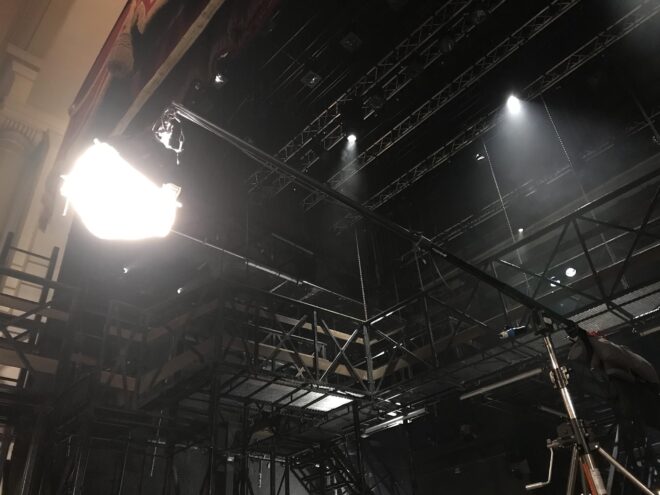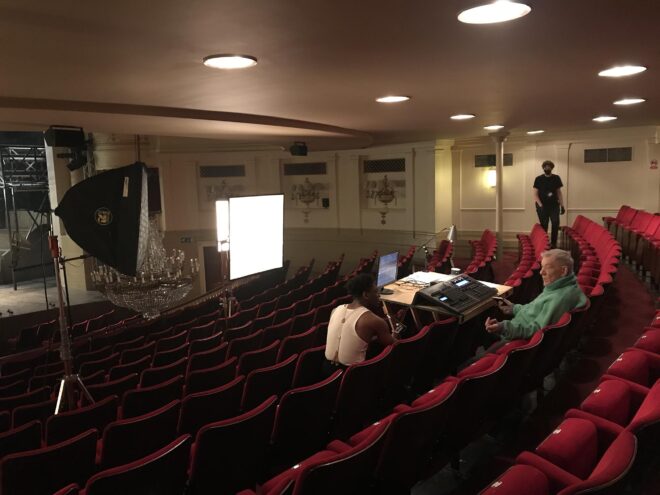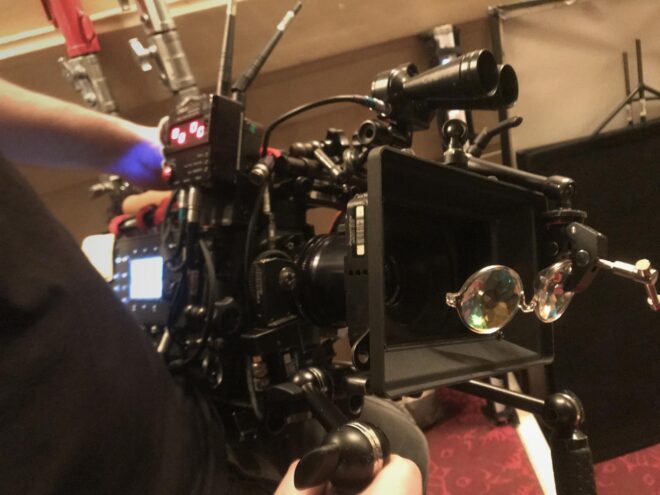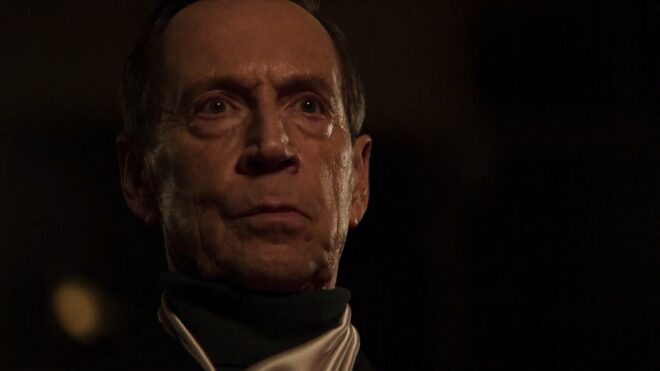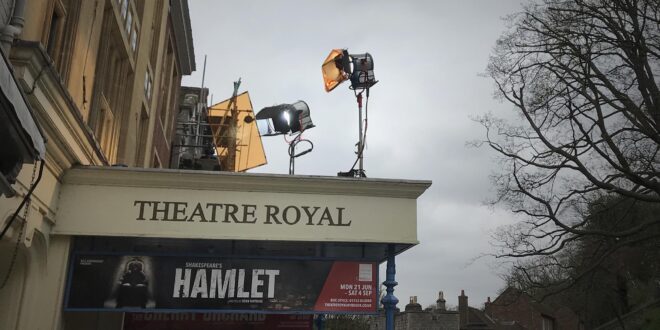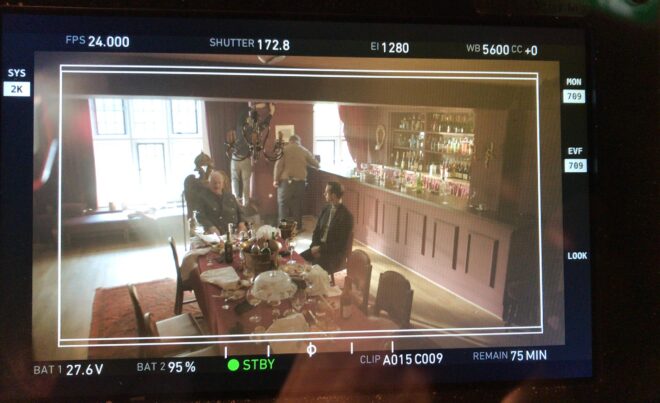“If the audience starts looking at the cheeseboard, we’ve had it.”
– Sir Ian McKellen
Following the well-reviewed recent cinema release of Hamlet, which I shot for director Sean Mathias in 2021, here is the diary I kept during filming. You can also go back and read my blogs from prep if you’re interested.
Day 1 – 5/4/21
“A king may go a progress through the guts of a beggar”
Our progress began with scenes at the stage door, one of the few spaces in the theatre that has natural light coming in. Gaffer Ben Millar and I considered trying to add artificial light outside to the main window which was backlighting the scene, but instead we opted to light through a little side window with a Fomex wrapped in unbleached muslin. After a minor hiccup about blocking and crew shows, which hadn’t been planned for because we spent the last two weeks rehearsing, we bashed through three set-ups including two using Wes Anderson-esque central framing and eye-lines very close to camera.
Next up was a scene in the substage, next to the boiler room. Here we installed a practical tungsten bulkhead light on the wall as our key, adding to the extant yellowy-green fluorescents that illuminated parts of the background, and the Fomex spilling down a staircase. Lots of black negative space in the frame added to the moody look.
After lunch – during which I sorted out the footage transcoding plan with line producer Stephen Cranny and data wrangler Max Quinton – we moved to the glamorous location of the gents’ toilets for Ian McKellen’s first scene. The location had been very flat and white originally, but Ben’s crew rigged three Astera tubes to the tops of two walls – the two walls that we were mainly shooting towards – and that created a nice wrappy backlit look. Director Sean Matthias embraced the weirder shots I had storyboarded, which I was very happy about!
We also had a brief scene in a corridor outside the toilets, for which we relied largely on the existing practicals. Ben had already gelled the fluorescent emergency lights, and for the ceiling lights we turned off the one closest to camera, left the one in the midground with its pre-existing 25W bulb, and put a 60W bulb in the background one to create classic dark-to-light depth.
After wrap Ben and I had a meeting with Zoe Spurr, the theatrical lighting designer, to work out a plan for the upcoming stage scenes. By that time my brain had clocked off for the day, but Ben did his usual trick of identifying the right solution that I was too tired to see. That solution is to use less of the theatrical lighting than previously planned, which I think is what most people on the production want. We’ll see how it goes tomorrow, with our first auditorium and stage scenes!
Day 2 – 6/4/21
“The woman will be out”
Both of today’s scenes required wrenching emotional performances from the cast, who delivered in spades. We began with a well-planned scene in the SL vom. This, I have learnt from a fortnight working in a theatre, is short for “stage left vomitorium”. I’m not entirely sure the theatre crew weren’t winding me up when they told me this. Anyway, it’s an enclosed little space opening onto a short flight of steps up to the stage. The walls are deep red and Lee had stuffed it full of booster seats in the same colour, giving it a rich and striking look. We used the Cooke Varotal 25-250mm zoom for the first time, which is an absolute beast, but enabled us to get a lovely slow push-in to Gertrude during a long speech. I stayed on the zoom for the rest of the scene for speed. The lighting was nearly all motivated by a practical in the ceiling, but we ended up adding quite a few other sources to make the look more flattering, including a Fomex on the ceiling wrapping the practical light, a 1K into poly as fill and tiny little LED for eye-light.
This little LED came in handy again for the second scene, giving a beautiful glint in the characters’ eyes. Here the main source was a Jem ball wrapped in unbleached muslin, which Sean particularly liked as a source. A 2K through diffusion in one of the boxes provided a second key for certain people. We saw a lot of the stage for the first time, and we used Zoe’s theatre lights to illuminate the metalwork of the set and give us a strong, graphical backlight. Ben added Astera tubes and Rifas to softly light the woodwork and separate it from the black walls. The hilariously low-tech wheelchair dolly was broken out for the first time, but the bazooka mount proved too wobbly so I ended up keeping the camera on my shoulder. The prism saw its first use too, mounted to a noga arm in front of the matte box to give us some weird blur and a slight kaleidoscope effect for a handheld shot of the mentally-ill Ophelia. One problem was that it kept reflecting the crew, the equipment and the boom, so that will have to be cut around.
Day 3 – 7/4/21
“Denmark’s a prison”
Today’s work was all in the auditorium and covered many pages of dialogue. We began at the back of the stalls, where the existing down-lighters (previously re-bubbled) and emergency lights (gelled with straw and ND) motivated all the lighting and genuinely provided a fair bit of it too. We used Rifas and Litemats wrapped in unbleached muslin to key the close-ups, and added some poly bounce after hearing via Susannah in make-up that Ian wanted a more flattering look!
In the afternoon we moved down into the stalls, where we had lots more text and twelve characters to cover! Needless to say, we went into overtime and still owed a couple of set-ups, despite covering large swathes with a few carefully-chosen handheld shots. By this point I was leaving the lighting almost entirely to Ben, as Sean was relying on me (with help from 1st AD Top Tarasin and script supervisor Jodie Woodall) to work out the coverage. Ben used several soft sources in combination with the auditorium’s existing practicals, which looked lovely but did give the soundies a few boom-shadow headaches!
Day 4 – 8/4/21
“The purpose of playing”
We began in the rear stalls again, this time introducing the tiny lighting box too, from which Claudius and Polonius spy on Hamlet as he asks one of the acting troupe to add a speech into the evening’s play. We turned out the house lights and motivated everything from two desk lamps and the stage itself, on which Hamlet was supposedly in the process of designing the play’s lighting. We used two Rifas (one through a frame) for the stage light, plus a 5K to give an edge on the seats. A small LED provided eye-light supposedly bounced up from one of the desk lamps. The other desk lamp, the one in the box, was genuinely bounced off white show card on the table to provide a sinister up-light on Claudius. An existing fluorescent tube behind him served as backlight after being gelled with .3 ND, while we brought Polonius up by hiding the little LED again.
We managed to cram the camera package – complete with zoom – into the back corner of the lighting box to do a lovely shot over Claudius through the lighting-box window to Hamlet and the player beyond. For the shots closer to these latter two characters, I switched to handheld shooting, having learnt the previous day that trying to set up sticks amongst the auditorium seating is a bit of a nightmare. Fortunately the handheld look worked well for this scene.
For the rest of the day we tackled part of the prologue for the first time. In this prologue, the cast are trapped inside the theatre without an audience and decide to put on Hamlet for themselves. I set the white balance right down to 2500K so that the stage set’s fluorescent tubes (which were daylight, but gelled with half CTO by us earlier in the week) went white with a touch of green, and kept the lighting fairly flat and uninviting. We used no haze and kept the theatrical lighting to an absolute minimum. I tried to pick up the pace and power through the shots so we could fit in the dropped material from yesterday – keeping the camera on my shoulder and encouraging simple lighting set-ups – but there were simply too many other elements to juggle, and though we made the day’s call sheet we did not repair yesterday’s damage.
My favourite shot of the day, and of the whole shoot so far, was done before lunch. It was part of the prologue, but a dreamy foreshadowing of Hamlet coming to life. I shot Claudius and Gertrude waltzing on stage with the blurry chandelier glowing in the foreground. All the lighting came from Zoe’s theatrical rig, there was haze aplenty, and most importantly we clamped a £4.99 pair of kaleidoscope glasses to the front of the matte box. On a 100mm lens, this had little effect on the actors but it splintered and repeated the chandelier lights in an utterly entrancing way. Combined with shooting at 48fps the shot was absolutely beautiful.
Day 5 – 9/4/21
“Poison in jest”
News of the death of Prince Phillip at Windsor Castle, literally across the road from both the theatre and our hotel, trickled through the crew this morning. This will likely affect production in several ways, the most immediate of which is that we have to move rooms within the hotel, the ones that look out onto the high-street being highly coveted by paparazzi with their long lenses and ghoulish ambitions. It was a day of ill health amongst the cast and crew too, and data wrangler Max had to step in to help out the reduced camera department.
Our first scene was behind the closed “tabs” (curtains) on the stage; we relied mostly on the set’s fluorescents for this, turning off foreground ones to give us more shape. Zoe provided a hard raking light on the back of the curtain. Outside in the auditorium, Ben used two Jem balls (one as hairlight, one as a key) plus 300W kickers from each side to illuminate Claudius and Gertrude.
The next scene was the play within the play, “The Murder of Gonzago”, or, as Hamlet dubs it, “Mousetrap”. Zoe of course took the lead in lighting this, making adjustments primarily to avoid casting nasty shadows on the leads. Ben again added a Rifa to key the close-ups.
We continue to stick very closely to my storyboards, which I have mixed feelings about. On the one hand, we know exactly what we’re doing in advance, and I’ve given a fair bit of thought to the shots throughout prep, but on the other hand I sometimes wonder if there wasn’t a better shot that I failed to spot because I was following the boards by rote. I try to look at my spreadsheet and mood-board at least once a day to remind myself of my original intentions and keep myself on track.
Day 6 – 10/4/12
“This is the very ecstasy of love”
First up was a short scene on and under the stage; two traps were being used as the graves dug by Shakespeare’s pair of “clowns”. Coverage included a shot looking through a hole inside one trap to Llinos underneath the other, then rising up as she climbed a ladder onto stage level. For this we broke out the Easy Rig for the first time, to take the camera’s weight. Lighting below the stage was motivated by a bulkhead (the same one used on day one) with a warm Astera tube cheated in too, while on the stage a wonderful sixties handheld floodlight was sitting beside the clowns. Ben used a Rifa gelled with (I think) half CTB to enhance the slightly cold light from this practical, while a couple more Astera tubes and some low-level house lights prevented the backgrounds from going completely black.
Next we moved up to the circle bar, which Lee had so beautifully transformed from the ugly, white room of our first recce to a decadent gentleman’s club strewn with the refuse of an indulgent party. I had always known that I wanted low morning sun glaring in through the window, and Ben accomplished this using a 6K par for the larger window and a 2.5K for the smaller one, both gelled with Full Straw. The curtains, bolton and some diff on the window helped to shape this and ensure that camera shadows were not an issue even when I was shooting with my back to the light. Deeper into the room, an Astera tube on a DJ’s desk and a few floor lamps added to the light. Most of the nasty ceiling lights were turned off, but two or three were snooted with black wrap and allowed to spill a little onto the scene. Reverses were fairly simple, shooting into the window which threw beams of light into the smoke (pretty much the only time I’ll be doing that on this movie!) and using a Rifa or bounce boards to fill in faces. For a later part of the scene we added diff to the Straw frame and an additional diff frame inside the room to create a beautiful, creamy light on Alice’s face.
One week down, three to go!

